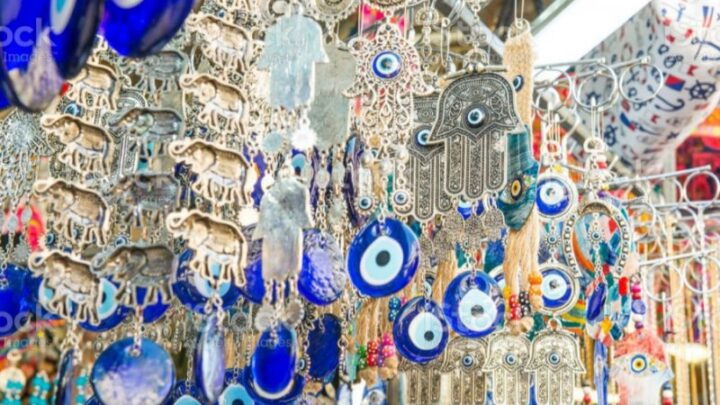Good luck to all those seeking education! Are you prepared to be astounded by some very amazing facts about the Hamsa hand? This well-known image, which may be found in many cultures and religions, is thought to bring good fortune and ward from evil. And believe me when I say that it’s much more than just a pretty decoration for your wall.
So settle in, pour yourself a cup of tea (or whatever beverage of choice you choose), and get ready to have some pretty fascinating facts about the Hamsa hand revealed to you.
1. The Middle Eastern and Mediterranean cultures have deep historical origins in the Hamsa hand.
The Middle Eastern and Mediterranean cultures are the origins of the ancient sign known as the. Ancient civilizations like the Phoenicians and the ancient Egyptians are where it first emerged. The Hamsa hand was frequently connected with deities in various civilizations, and it was thought to provide luck and protection.
Judaism, Islam, and Hinduism are just a few of the religions that have adopted the . The Hand of Miriam, also known as the Hamsa hand in Judaism, is frequently pictured with the Hebrew letter “shin,” which stands for the name of God.
The , also known as the Hand of Fatima in Islam, is connected to the prophet Muhammad’s daughter. The Hamsa hand is worshipped in Hinduism asa symbol of the divine and is often associated with the god Vishnu.
Even though it has ancient roots, the is still a well-known emblem today. It may be seen in many various contexts, such as as a decorative element on jewellery, home decor, and other goods.
2. In many religions, including Judaism, Islam, and Hinduism, the Hamsa hand is treasured as a sign of protection and good fortune.
The Hamsa hand is often regarded as a lucky charm and a sign of protection. It is thought to defend against evil forces and energies as well as bestow blessings and positive energy on those who own it. The Hamsa hand frequently has an eye in the middle, which is considered to represent the fact that God is all-seeing. This eye is used to ward off the “evil eye,” which is thought to be a harmful energy that can hurt or bring bad luck.
The Hamsa hand is associated with luck and protection, but it is also viewed as a sign of enlightenment and spiritual direction. It is thought to aid the owner in connecting with their inner wisdom and identifying their purpose in life.
Depending on the culture and setting, the can be used to represent a variety of various meanings and symbols. It is connected with strength and power in certain contexts while being viewed as a sign of femininity and fertility in others. The Hamsa hand is valued as a representation of positivity, wealth, and spiritual development in general.
A number of different civilizations and faiths venerate and use the as a significant cultural emblem. The Hamsa hand, also known as the Hand of Miriam, is a potent sign of protection and luck in Judaism. It is frequently on display in homes and synagogues as a means of protecting occupants from evil spirits and bringing blessings.
The Hamsa hand, also known as the Hand of Fatima in Islam, is connected to the prophet Muhammad’s daughter. It is frequently worn as a necklace or displayed in homes and mosques as a sign of heavenly protection.
The Hamsa hand is regarded in Hinduism as a representation of the divine and is frequently connected to the god Vishnu. Those who possess it are said to receive blessings and good fortune.
Buddhism, Christianity, and the Baha’i faith are just a few of the numerous cultures and religions that use the Hamsa hand. The Hamsa hand is revered as a sign of protection, fortune, and spiritual guidance in each of these cultures.
The Hamsa hand frequently has an eye in the centre, signifying that God is all-seeing.
The Hamsa hand frequently has an eye in the middle, which is considered to represent the fact that God is all-seeing. This eye, often known as the “Eye of Providence,” is believed to symbolise God’s vigilant and kind character.
The “evil eye,” which is regarded as a malevolent power that can damage or bring bad luck, is considered to be repelled by the inclusion of the eye in the centre of the . In some cultures, the evil eye is believed to result from jealously or envy and can damage those who are the targets of these negative emotions. The eye is included in thecenter of the Hamsa hand, it is believed that the symbol can deflect and protect against the negative energies of the evil eye.
The eye in the middle of the Hamsa hand is said to symbolise God’s all-seeing, all-knowing nature in addition to its protecting properties. It serves as a reminder that God is ever-present, aware of all that occurs, and able to give direction and protection to those who turn to him.
In conclusion, the is a well-known emblem with a colourful past and deep cultural importance. Its origins can be found in the Middle Eastern and Mediterranean cultures of antiquity, where it was treasured as a sign of safety and luck. Judaism, Islam, and Hinduism are just a few of the nations and religions that still utilise and honour the today. Its ongoing cultural significance is shown to by its enduring popularity as a decorative element on jewellery, home decor, and other objects. The is a potent sign that will bring blessings and positive energy into your life, whether you’re seeking protection, good fortune, or spiritual guidance.
you can also read about: The struggle to stay stylish on a budget



